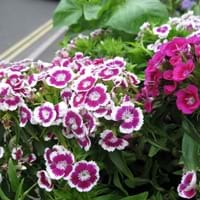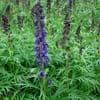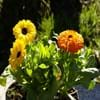Life Span
Biennial and Perennial
Perennial
Type
Flowering Plants
Flowering Plants, Herbaceous Perennial
Origin
Europe, Northern Europe, Western Europe
Asia
Types
'Bellagio Apricot' begonia, 'Bellagio Blush' begonia, 'Bellagio Pink' begonia
Bowl of Beauty, Laura Dessert
Number of Varieties
Not Available
Habitat
Subtropical climates, Tropical regions
Dappled Shade, Woodland Garden
USDA Hardiness Zone
3-9
4-8
Sunset Zone
21,22
A3, 1a, 1b, 2a, 2b, 3a, 3b, 4, 5, 6, 7, 8, 9, 10, 11, 12, 13, 14, 15, 16, 17, 18, 19, 20, 22
Habit
Cushion/Mound-forming
Clump-Forming
Flower Color
White, Yellow, Red, Pink, Light Pink, Rose, Dark Red, Orange Red
White, Light Pink
Flower Color Modifier
Bicolor
Bicolor
Fruit Color
Not Available
Not Available
Leaf Color in Spring
Light Green, Blue Green, Gray Green
Red, Dark Green, Bronze
Leaf Color in Summer
Light Green, Blue Green, Gray Green
Green, Dark Green
Leaf Color in Fall
Light Green, Blue Green, Gray Green
Green, Dark Green, Bronze
Leaf Color in Winter
Light Green
Not Available
Leaf Shape
Long Linear
Lance shaped
Plant Season
Spring, Summer, Fall
Spring, Summer
Sunlight
Full Sun, Partial Sun
Full Sun, Partial Sun
Type of Soil
Loam
Clay, Loam, Sand
The pH of Soil
Neutral
Acidic, Neutral, Alkaline
Soil Drainage
Well drained
Well drained
Bloom Time
Early Spring, Spring, Late Spring
Late Spring, Early Summer
Tolerances
Drought, Shade areas
Not Available
Where to Plant?
Container, Ground, Pot
Ground
How to Plant?
Divison, Seedlings, Stem Planting
Root Division, Seedlings
Plant Maintenance
Low
Medium
Watering Requirements
Needs watering once a week
Allow soil to be completely dry in between waterings, Water Deeply
In Summer
Moderate
Lots of watering
In Spring
Moderate
Moderate
In Winter
Average Water
Average Water
Soil pH
Neutral
Acidic, Neutral, Alkaline
Soil Type
Loam
Clay, Loam, Sand
Soil Drainage Capacity
Well drained
Well drained
Sun Exposure
Full Sun, Partial Sun
Full Sun, Partial Sun
Pruning
Cut or pinch the stems, Remove damaged leaves, Remove dead branches, Remove dead leaves
Remove damaged leaves, Remove dead branches, Remove dead leaves
Fertilizers
All-Purpose Liquid Fertilizer, fertilize in growing season, fertilize in spring, fertilize in summer
5-10-10 fertilizer
Pests and Diseases
Fusarium wilt, Gray mold, Leaf spot, Root rot, Rust, Slugs
Leaf Blotch, Ringspot virus, Stem rot, Tip blight, Verticillium Wilt
Plant Tolerance
Drought, Shade areas
Drought
Flower Petal Number
Single, Double, Semi-Double
Double
Foliage Texture
Fine
Coarse
Foliage Sheen
Matte
Glossy
Attracts
Not Available
Ants, Butterflies, Not Available
Allergy
Asthma
no allergic reactions
Aesthetic Uses
Beautification, Bouquets, Cottage Garden
Cut Flowers, Showy Purposes
Beauty Benefits
Not Available
Not Available
Environmental Uses
Air purification
Air purification
Medicinal Uses
Bronchitis, Candidiasis, Cold, Digestive disorders, Dysentry, Haemoptysis, Liver problems, Menstrual Disorders, Scrofula, Swelling
Alterative, Analgesic, Anodyne, anti inflammatory, Antibacterial, Antiseptic, Hypotensive, Tonic
Part of Plant Used
Whole plant
Root, Seeds, Stem
Other Uses
Food for animals
Eaten in a broth, Powdered and mixed with tea
Used As Indoor Plant
Yes
Yes
Used As Outdoor Plant
Yes
Yes
Garden Design
Bedding Plant, Container, Cutflower, Feature Plant, Groundcover, Hanging Basket, Mixed Border, Rock Garden / Wall
Cutflower, Feature Plant, Foundation, Mixed Border
Botanical Name
DIANTHUS barbatus 'Heart Attack'
PAEONIA lactiflora 'Shirley Temple'
Common Name
Heart Attack Sweet William, Sweet William
Double Pink Peony, Garden Peony
In Hindi
स्वीट विलियम
Double Pink Peony
In German
Bartn
Doppelte rosa Pfingstrosen
In French
sweet william
Double Rose pivoine
In Spanish
Guillermo dulce
Doble Pink Peony
In Greek
είδος γαρύφαλλου
Διπλό Ροζ Παιωνία
In Portuguese
william doce
Duplo Pink Peony
In Polish
słodki William
Podwójne Pink Peony
In Latin
amaranthus
Geminus Pink AGLAOPHOTIS
Phylum
Magnoliophyta
Magnoliophyta
Class
Magnoliopsida
Magnoliopsida
Order
Caryophyllales
Dilleniales
Family
Caryophyllaceae
Paeoniaceae
Clade
Angiosperms, Core eudicots, Eudicots
Angiosperms, Core eudicots, Eudicots
Tribe
Not Available
Not Available
Subfamily
Not Available
Not Available
Number of Species
Not Available
Not Available
Importance of Sweet William and Double Pink Peony
Want to have the most appropriate plant for your garden? You might want to know the importance of Sweet William and Double Pink Peony. Basically, these two plants vary in many aspects. Compare Sweet William and Double Pink Peony as they differ in many characteristics such as their life, care, benefits, facts, etc. Every gardener must at least have the slightest clue about the plants he wants to plant in his garden. Compare their benefits, which differ in many ways like facts and uses. The medicinal use of Sweet William is Bronchitis, Candidiasis, Cold, Digestive disorders, Dysentry, Haemoptysis, Liver problems, Menstrual Disorders, Scrofula and Swelling whereas of Double Pink Peony is Alterative, Analgesic, Anodyne, anti inflammatory, Antibacterial, Antiseptic, Hypotensive and Tonic. Sweet William has beauty benefits as follows: Not Available while Double Pink Peony has beauty benefits as follows: Not Available.
Compare Facts of Sweet William vs Double Pink Peony
How to choose the best garden plant for your garden depending upon its facts? Here garden plant comparison will help you to solve this query. Compare the facts of Sweet William vs Double Pink Peony and know which one to choose. As garden plants have benefits and other uses, allergy is also a major drawback of plants for some people. Allergic reactions of Sweet William are Asthma whereas of Double Pink Peony have no allergic reactions respectively. Having a fruit bearing plant in your garden can be a plus point of your garden. Sweet William has no showy fruits and Double Pink Peony has no showy fruits. Also Sweet William is not flowering and Double Pink Peony is not flowering . You can compare Sweet William and Double Pink Peony facts and facts of other plants too.





